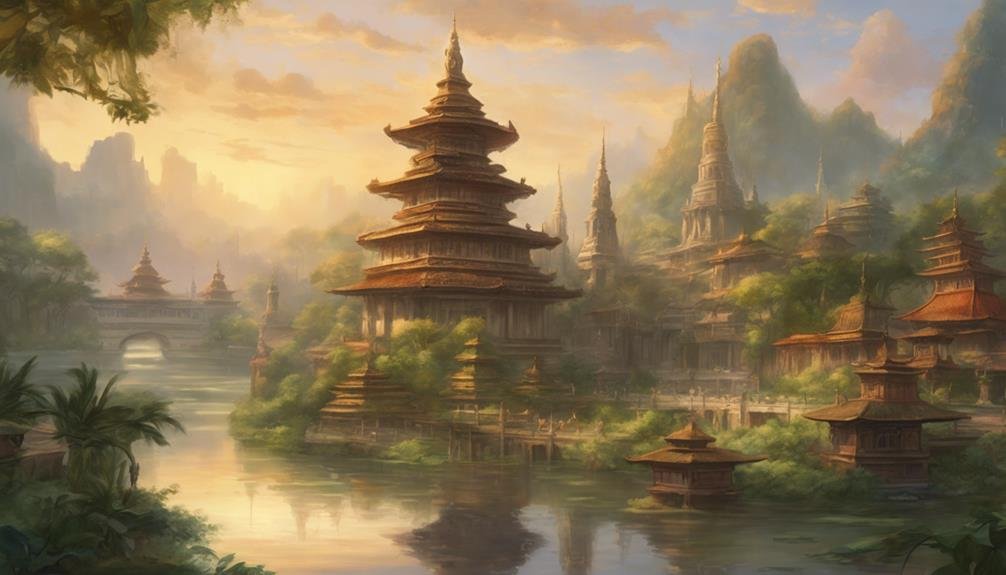How different religious traditions describe paradise is fascinating, each offering a unique vision of ultimate bliss. In Christianity, Heaven is often depicted as a place of eternal communion with God. Islam describes Jannah as a lush garden of spiritual and physical pleasures for the faithful. Buddhism, on the other hand, envisions Nirvana as a state of liberation from suffering. Indigenous beliefs, like the Land-Without-Evil, highlight harmony with nature. These diverse interpretations raise intriguing questions about what humans universally seek in their quest for spiritual fulfillment. So, what exactly do these paradises have in common?
Key Takeaways
- Heaven in Christianity and Jannah in Islam represent eternal bliss and communion with God, attainable through faith and good deeds.
- Nirvana in Buddhism and the Land-Without-Evil in Indigenous Beliefs signify liberation from suffering and perfect spiritual fulfillment.
- The Garden of Eden in Biblical tradition symbolizes divine perfection and human flaws, reflecting universal themes of paradise myths.
- Egyptian beliefs describe paradise as the House of Song, a realm of everlasting joy and immortality in the afterlife.
- Chinese traditions influenced by Confucianism and Taoism envision earthly paradise as an ideal existence, embodying harmony and tranquility.
Paradise in Christianity

In Christianity, heaven is viewed as a place where believers find eternal rest and communion with God. It’s a core part of Christian beliefs that those who live righteous lives on Earth will be rewarded in heaven. This heavenly reward isn’t just about rest but also about experiencing God’s glory and joy.
Christian teachings emphasize that heaven is a heaven of eternal bliss and fulfillment. Imagine a paradise where every moment is filled with God’s presence, and you’re in constant communion with Him. This connection isn’t temporary; it’s everlasting, providing a sense of peace and fulfillment that transcends earthly experiences.
The concept of heaven as a Heavenly afterlife is central to the faith. Believers are encouraged to live according to God’s teachings, with the promise of eternal rest and joy as their reward. This promise isn’t just a fleeting hope; it’s a fundamental aspect of Christian beliefs, motivating followers to aim for righteousness.
Salvation and Paradise in Islam
While Christianity envisions heaven as a heaven of eternal communion with God, Islam presents a vivid picture of paradise, known as Jannah, as a garden of eternal bliss and pleasure. In the Quran, Jannah is described as a heavenly Garden filled with rivers of milk, honey, and wine, where every desire is fulfilled. This concept of an earthly paradise isn’t just spiritual but also sensual, offering both physical delights and the profound joy of being in God’s presence.
Islamic teachings emphasize that salvation and entry into this paradise are achieved through righteous deeds and unwavering faith. Unlike the Book of Revelation’s depiction of heaven, IslaHeavent often illustrates Jannah as a lush, green sanctuary, echoing the imagery of the Tree of Life, which symbolizes eternal life and divine blessings.
Jannah’s promise is a powerful motivator for Muslims to live morally upright lives. The Quran’s vivid descriptions of paradise—a place of ultimate joy, peace, and fulfillment—reinforce the belief that the rewards for the faithful are immeasurable. Essentially, Jannah represents the culmination of a life lived by God’s will, offering an eternal, blissful existence.
Enlightenment and Nirvana in Buddhism

Buddhism offers a profound path to spiritual liberation through the attainment of enlightenment and Nirvana. As the ultimate goal in Buddhism, Nirvana represents the cessation of suffering and the end of the cycle of rebirth. Achieving enlightenment, or awakening, involves deep meditation, wisdom, and understanding reality’s true nature. You must let go of attachments, desires, and the ego to reach this state, achieving spiritual liberation.
Buddhist teachings emphasize several key principles to guide you on this journey:
- Impermanence: Recognize that all things are transient and change is inevitable.
- Compassion: Cultivate kindness and empathy towards all living beings.
- Wisdom: Seek to understand the true nature of existence and reality.
- Meditation: Practice mindfulness and focus to develop inner peace and clarity.
- Detachment: Release your hold on material possessions and personal desires.
Nirvana is described as a state of perfect peace, freedom, and contentment that transcends the limitations of the physical world. By following these teachings, one can move closer to the ultimate goal of enlightenment and experience profound spiritual liberation within the framework of Buddhism.
Land-Without-Evil in Indigenous Beliefs
Many Indigenous cultures cherish the idea of the Land Without Evil, a paradise where suffering and hardship don’t exist. In these beliefs, this utopian vision symbolizes a perfect existence, a domain where harmony with nature prevails, and every being experiences exceptional happiness. The Land Without Evil isn’t just a mythical place but a profound spiritual aspiration reflecting a longing for a state of blissful existence.
Various interpretations of this paradise exist across different indigenous traditions. For some, it’s a literal place they hope to see, while for others, it’s more of a spiritual state or a guiding principle in their daily lives. This concept emphasizes living in balance with the environment, fostering communal well-being, and striving for an ideal life devoid of malice and suffering.
The idea of the Land Without Evil resonates deeply because it offers hope and a sense of purpose. It reminds us that a perfect existence, filled with exceptional happiness and free from hardship, is within reach if we live in harmony with the world around us. Such beliefs highlight the profound connection between Indigenous cultures and their reverence for nature and community.
Historical and Linguistic Analysis

The concept of paradise has deep historical and linguistic roots that reveal its evolving significance across various cultures and religions. The word “paradise” originated from a Proto-Indo-European (PIE) root meaning “to stick and set up” and “around,” eventually transforming to signify a garden or park in various cultures. This evolution underscores how paradise is often depicted as a lush Garden, an image of paradise that transcends time and geography.
In the Near East, different religious traditions have unique accounts of a primordial paradise:
- Jewish eschatology: Higher Gan Eden as the Garden of Righteousness.
- Rabbinic Judaism: Distinguishing between lower and higher Gan Eden as celestial abodes.
- Early Christian theology: Differentiating paradise from heaven, seeiHeavenas an earthly school for righteous souls.
- Jehovah’s Witnesses: Believing in a restored earthly paradise after Armageddon.
- Mormonism: Viewing paradise as the spirit world for the righteous after death.
Islamic gardens and landscapes often symbolize paradise, incorporating central water features and serene ambiances described in the Quran. These historical and linguistic analyses demonstrate the rich tapestry of paradise’s meaning, deeply rooted in human aspiration for an ideal, harmonious existence.
Do Different Religious Traditions View Marriage in Heaven as Part of Their Concept of Paradise?
Different religious traditions offer diverse interpretations of the afterlife, often intertwining concepts of marriage and spirituality beyond life. In some beliefs, a sacred union is seen as a continuation of earthly bonds, while others view the soul’s connection to the divine as the ultimate fulfillment of happiness in paradise.
Global Traditions of Paradise
Many global traditions share the idea of a primordial paradise, depicting a perfect society free from suffering and death. Narratives like the Biblical Garden of Eden and the Greek Golden Age highlight striking similarities across cultures. Ancient civilizations such as Sumer, Egypt, and China also portrayed a harmonious paradise, often lost due to human actions.
Primordial Paradise Themes
Across various ancient civilizations, tales of a primordial paradise abound, reflecting humanity’s enduring fascination with a state of perfect harmony and abundance. These narratives often revolve around idealized domains where:
- The Biblical Garden of Eden symbolizes innocence and divine communion.
- The Greek Golden Age depicts a time when humans lived in peace and prosperity without toil.
- Sumerian and Egyptian paradise myths describe fertile lands blessed by the gods.
- Chinese legends speak of utopian lands filled with immortality and eternal bliss.
- Indigenous traditions, such as the Land-Without-Evil, narrate an existence free from suffering and hardship.
These primordial paradise themes share a common thread: an idyllic existence suddenly disrupted by human actions, leading to the loss of perfection. For example, the Garden of Eden’s bliss ends with Adam and Eve’s disobedience, while the Golden Age declines as human morality deteriorates.
Similarly, stories from Greece to Guatemala capture this universal longing and the inevitable challenges of interpreting such paradises.
Cultural Paradise Narratives
How do different cultures around the world envision paradise? Various traditions, such as Biblical, Greek, Sumerian, Egyptian, and Chinese, share a narrative of a primordial paradise. This idyllic state often reflects the harmony between heaven and eHeavenembodying a place of eternal abundance and peace. For instance, the Biblical tale of Adam and Eve in the Garden of Eden illustrates a divine paradise disrupted by human actions, mirroring similar themes in other cultures.
In Mesoamerican myths, paradise is depicted as a New World filled with pleasures and divine dilemmas. Like in other traditions, this paradise eventually falls due to human flaws.
The ancient Egyptians imagined a paradise called the House of Song, where the deceased would enjoy everlasting joy. Similarly, Chinese traditions speak of an earthly paradise where immortality and harmony reign supreme.
Scholars continually debate the diffusion and interpretation of these paradise myths. They explore how these narratives have influenced different historical and cultural contexts. Despite their unique elements, these global traditions of paradise share a common thread: a vision of an ideal existence that’s ultimately disrupted, reflecting universal human aspirations and shortcomings.
Conclusion
Exploring paradise across religious traditions, you’ll find a shared longing for ultimate peace and fulfillment. Whether it’s Heaven in Christianity, Jannah in Islam, Nirvana in Buddhism, or the Land-Without-Evil in Indigenous beliefs, each vision reflects a deep human desire for spiritual transcendence and harmony. Understanding these diverse interpretations reminds you of our universal quest for contentment and connection with the divine, transcending cultural and religious boundaries. Embrace this shared aspiration for a more harmonious existence.
FAQs
What is paradise in Christianity?
In Christianity, paradise is often associated with Heaven, a plHeaven eternal peace and communion with God after death. It rewards the righteous and those who believe in Jesus Christ. Paradise is a place free from pain, suffering, and sin, where believers are united with God and experience eternal joy.
Key Beliefs:
- Associated with Heaven.
- Place of eternal peace and joy with God.
- Reward for the righteous and faithful.
How is paradise viewed in Islam?
In Islam, paradise is known as Jannah, a place of eternal bliss and reward for the faithful who have lived a righteous life by God’s will. The Quran describes Jannah as a lush garden with flowing rivers, where believers enjoy physical and spiritual pleasures. It is a place of eternal peace, free from suffering, where people are near God.
Key Beliefs:
- Known as Jannah, a garden of eternal bliss.
- Reward for the righteous and faithful.
- It is described as a place of peace, beauty, and closeness to God.
What is the concept of paradise in Hinduism?
In Hinduism, paradise can be linked to Svarga, a heavenly realm where virtuous souls experience pleasure and rest after death. However, Svarga is considered temporary, as souls eventually reincarnate. The ultimate goal in Hinduism is Moksha, liberation from the cycle of birth and rebirth (samsara), and union with the divine.
Key Beliefs:
- Svarga is a temporary heavenly realm for virtuous souls.
- Paradise is not permanent, and reincarnation follows.
- The ultimate goal is Moksha, liberation from the cycle of rebirth.
How does Buddhism view paradise?
In Buddhism, paradise can be seen as a Pure Land, especially in Pure Land Buddhism, where devotees aspire to be reborn in the Pure Land of a Buddha, such as Amitabha’s Western Paradise. This is considered a realm of happiness and ease where it is easier to attain enlightenment. However, the ultimate goal in Buddhism is Nirvana, the end of suffering and the cycle of rebirth.
Key Beliefs:
- Pure Land as a paradise for spiritual progress.
- The ultimate goal is Nirvana, freedom from suffering, and rebirth.
- Pure Land is a realm where attaining enlightenment is easier.
How is paradise understood in Judaism?
In Judaism, paradise is often called Gan Eden (the Garden of Eden), a place where the righteous go after death to experience eternal peace and rest. It is considered a place of reward for living a life by God’s commandments. Unlike Christianity or Islam, the afterlife is less emphasized in Judaism, focusing more on living a righteous life in the present.
Key Beliefs:
- Gan Eden is a place of eternal rest for the righteous.
- There is less emphasis on the afterlife and more on present righteousness.
- A reward for following God’s commandments.

